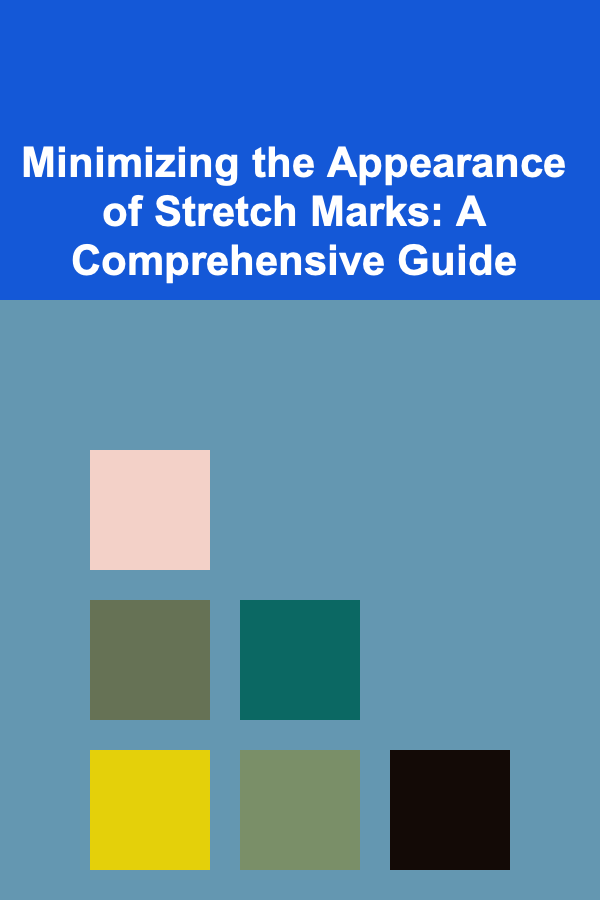
Minimizing the Appearance of Stretch Marks: A Comprehensive Guide
ebook include PDF & Audio bundle (Micro Guide)
$12.99$6.99
Limited Time Offer! Order within the next:

Understanding Stretch Marks: More Than Skin Deep
Stretch marks, medically known as striae distensae, are a common skin condition characterized by linear, atrophic dermal scars. They appear as streaks or lines on the skin, often differing in color and texture from the surrounding skin. While not a health risk, they can be a significant cosmetic concern for many individuals, affecting self-esteem and body image. To effectively address stretch marks, it's crucial to understand their formation and underlying mechanisms.
Stretch marks typically develop when the skin is rapidly stretched, whether due to pregnancy, weight gain or loss, puberty, or muscle growth. This rapid stretching disrupts the normal production of collagen and elastin, the proteins responsible for skin elasticity and strength. Think of the skin like a rubber band. If stretched slowly and within its limits, it returns to its original shape. However, if stretched too quickly or too far, the rubber band can tear, leaving permanent damage. Similarly, rapid stretching overwhelms the skin's capacity to remodel and adapt, leading to structural damage in the dermis, the middle layer of the skin.
Specifically, the tearing of collagen and elastin fibers triggers an inflammatory response. This inflammation manifests as the initial appearance of stretch marks, which are typically red or purple (striae rubrae). Over time, the inflammation subsides, and the stretch marks gradually fade to a paler, often silvery or white color (striae albae). This change in color reflects the reduced blood flow to the affected area and the reorganization of the dermal structure.
Genetic predisposition also plays a significant role. Some individuals are simply more prone to developing stretch marks than others. If your parents or siblings have stretch marks, you are more likely to develop them yourself. Hormonal factors also contribute. Fluctuations in hormone levels, particularly during puberty and pregnancy, can weaken the skin and make it more susceptible to stretching. For example, increased levels of cortisol, a stress hormone, can inhibit collagen production.
Therefore, understanding the interplay of skin stretching, collagen and elastin disruption, genetic factors, and hormonal influences is paramount for developing effective strategies to prevent and minimize the appearance of stretch marks.
Prevention is Key: Proactive Measures for Skin Health
While completely preventing stretch marks may not always be possible, especially considering genetic predispositions, proactive measures can significantly reduce their likelihood and severity. The foundation of stretch mark prevention lies in maintaining skin hydration and elasticity.
Hydration: Inside and Out
Proper hydration is essential for overall skin health. Drink plenty of water throughout the day. Aim for at least eight glasses of water daily. Hydrated skin is more pliable and resilient to stretching. In addition to internal hydration, external hydration through topical moisturizers is crucial.
Moisturization: Targeting the Skin's Barrier
Regularly moisturizing the skin, particularly in areas prone to stretch marks (abdomen, breasts, thighs, hips), helps maintain its elasticity and minimizes dryness. Choose moisturizers that are rich in emollients and humectants. Emollients, such as shea butter, cocoa butter, and coconut oil, help soften and smooth the skin by filling in the gaps between skin cells. Humectants, such as hyaluronic acid and glycerin, attract and retain moisture from the environment, keeping the skin hydrated.
Consider using products containing vitamin E, which is known for its antioxidant and moisturizing properties. Massaging the moisturizer into the skin can also improve circulation and promote collagen production. Apply moisturizer at least twice a day, especially after showering or bathing, when the skin is most receptive to hydration.
Weight Management: Gradual Changes for Skin Stability
Rapid weight gain or loss can put significant stress on the skin, increasing the risk of stretch marks. Maintain a healthy and stable weight through a balanced diet and regular exercise. If you are planning to lose weight, do so gradually. Aim for a weight loss of no more than 1-2 pounds per week. This allows the skin to adjust more easily and minimizes the risk of damage.
Nutritional Support: Fueling Skin Health from Within
A healthy diet rich in vitamins and minerals is crucial for maintaining skin elasticity and promoting collagen production. Focus on consuming foods that are rich in:
- Vitamin C: Essential for collagen synthesis. Good sources include citrus fruits, berries, and leafy green vegetables.
- Vitamin E: An antioxidant that protects skin cells from damage. Found in nuts, seeds, and vegetable oils.
- Zinc: Plays a role in wound healing and collagen production. Found in meat, poultry, seafood, and nuts.
- Protein: The building block of collagen and elastin. Include lean protein sources in your diet, such as chicken, fish, beans, and lentils.
Pregnancy-Specific Strategies: Supporting the Expanding Skin
Pregnancy is a major trigger for stretch marks. In addition to the general prevention strategies, pregnant women should pay particular attention to:
- Maintaining a healthy weight gain: Work with your doctor or midwife to determine a healthy weight gain range for your pregnancy.
- Gentle exercise: Regular exercise can improve circulation and skin elasticity. Consult your doctor about safe exercises during pregnancy.
- Consistent moisturization: Apply a pregnancy-safe moisturizer to your abdomen, breasts, and thighs at least twice a day. Look for products specifically formulated for pregnancy, as they are often free of potentially harmful ingredients.
Topical Treatments: Creams, Lotions, and Oils
A wide range of topical treatments claim to minimize the appearance of stretch marks. While no cream or lotion can completely erase stretch marks, some ingredients have been shown to be effective in improving their appearance, particularly when used on new (striae rubrae) stretch marks.
Retinoids: The Gold Standard (with Caveats)
Retinoids, derivatives of vitamin A, are among the most effective topical treatments for stretch marks. They work by stimulating collagen production, promoting cell turnover, and improving skin elasticity. Retinoids can significantly reduce the appearance of new stretch marks, making them less noticeable and more closely resembling the surrounding skin. However, it's important to note that retinoids are contraindicated during pregnancy and breastfeeding due to potential risks to the fetus or infant. Common retinoids used in stretch mark treatments include tretinoin (Retin-A), retinol, and retinyl palmitate.
When using retinoids, start with a low concentration and gradually increase it as tolerated. Apply the retinoid cream or lotion at night, as retinoids can make the skin more sensitive to sunlight. Use sunscreen with a high SPF during the day to protect the skin from sun damage. Common side effects of retinoids include dryness, redness, and peeling. If these side effects are bothersome, reduce the frequency of application or use a moisturizer.
Centella Asiatica: A Natural Collagen Booster
Centella Asiatica, also known as Gotu Kola, is a medicinal herb with potent wound-healing and collagen-boosting properties. It stimulates collagen synthesis and improves blood circulation, which can help reduce the appearance of stretch marks. Centella Asiatica extracts are often found in creams and lotions marketed for scar reduction and stretch mark treatment. It is generally considered safe for use during pregnancy, but it's always best to consult with your doctor before using any new topical treatment.
Hyaluronic Acid: Hydration and Plumping
Hyaluronic acid is a powerful humectant that attracts and retains moisture in the skin. While it doesn't directly stimulate collagen production, it can help plump up the skin and improve its overall appearance, making stretch marks less noticeable. Hyaluronic acid is generally well-tolerated and can be used in combination with other treatments.
Vitamin E: Antioxidant and Moisturizing
As mentioned earlier, vitamin E is an antioxidant that can protect skin cells from damage and improve skin hydration. While its effectiveness in directly reducing stretch marks is debated, it can contribute to overall skin health and may help improve the appearance of existing stretch marks when combined with other treatments.
Peptides: Signaling Collagen Production
Certain peptides, such as copper peptides, are believed to stimulate collagen production and improve skin elasticity. They work by signaling skin cells to produce more collagen and elastin. While more research is needed, some studies suggest that peptides may be effective in reducing the appearance of stretch marks.
Cocoa Butter and Shea Butter: Emollient and Soothing
Cocoa butter and shea butter are rich in emollients that can help soften and smooth the skin. While they may not directly reduce stretch marks, they can improve skin hydration and overall appearance, making stretch marks less noticeable. They are also generally safe for use during pregnancy.
When choosing a topical treatment, consider the ingredients, your skin type, and whether you are pregnant or breastfeeding. Always perform a patch test on a small area of skin before applying the product to a larger area to check for any allergic reactions or sensitivities. Be patient and consistent with your application, as it can take several weeks or months to see noticeable results.
Professional Treatments: Exploring Advanced Options
For more significant or persistent stretch marks, professional treatments offered by dermatologists or other qualified medical professionals may be considered. These treatments often involve more invasive procedures that can stimulate collagen production and improve skin texture.
Laser Therapy: Resurfacing and Rejuvenation
Laser therapy is a popular and effective treatment for stretch marks. Different types of lasers can be used, including fractional lasers, pulsed dye lasers, and ablative lasers. Fractional lasers create tiny micro-injuries in the skin, stimulating collagen production and improving skin texture. Pulsed dye lasers target the blood vessels in red stretch marks (striae rubrae), reducing their redness and making them less noticeable. Ablative lasers remove the outer layer of skin, promoting new skin growth and reducing the appearance of stretch marks.
Laser therapy typically requires multiple sessions to achieve optimal results. The number of sessions and the type of laser used will depend on the severity of the stretch marks and the individual's skin type. Side effects of laser therapy can include redness, swelling, and temporary changes in skin pigmentation. It is crucial to consult with a qualified dermatologist to determine the best type of laser therapy for your specific needs.
Microneedling: Stimulating Collagen with Precision
Microneedling, also known as collagen induction therapy, involves using a device with tiny needles to create micro-injuries in the skin. These micro-injuries stimulate collagen and elastin production, improving skin texture and reducing the appearance of stretch marks. Microneedling is a relatively non-invasive procedure with minimal downtime. It typically requires multiple sessions to achieve optimal results. Side effects can include redness, swelling, and minor bleeding.
Chemical Peels: Exfoliating for Renewal
Chemical peels involve applying a chemical solution to the skin, which exfoliates the outer layers and promotes new skin growth. Different types of chemical peels can be used, ranging from superficial peels to deep peels. Superficial peels can help improve skin texture and reduce the appearance of mild stretch marks. Deeper peels can be more effective for more severe stretch marks, but they also carry a higher risk of side effects, such as redness, peeling, and changes in skin pigmentation.
Microdermabrasion: Gentle Exfoliation
Microdermabrasion is a less invasive exfoliation technique that uses tiny crystals or a diamond-tipped wand to remove the outer layer of dead skin cells. This can improve skin texture and reduce the appearance of mild stretch marks. Microdermabrasion typically requires multiple sessions to achieve noticeable results. Side effects are usually mild and can include redness and dryness.
Radiofrequency: Tightening and Toning
Radiofrequency treatments use radiofrequency energy to heat the deeper layers of the skin, stimulating collagen production and tightening the skin. This can help reduce the appearance of stretch marks and improve skin elasticity. Radiofrequency treatments are generally safe and well-tolerated. Multiple sessions may be required to achieve optimal results.
Professional treatments for stretch marks can be effective, but they also come with potential risks and side effects. It is crucial to consult with a qualified medical professional to determine the best treatment option for your specific needs and to understand the potential risks and benefits. They can assess your skin type, the severity of your stretch marks, and your overall health to recommend the most appropriate and effective treatment plan.
Lifestyle Adjustments: Complementary Strategies for Skin Health
In addition to topical treatments and professional procedures, certain lifestyle adjustments can further contribute to minimizing the appearance of stretch marks and promoting overall skin health. These adjustments focus on optimizing nutrition, managing stress, and protecting the skin from environmental damage.
Stress Management: Reducing Cortisol Levels
Chronic stress can elevate cortisol levels, which can inhibit collagen production and weaken the skin. Implementing stress management techniques can help reduce cortisol levels and promote skin health. Consider incorporating activities such as yoga, meditation, deep breathing exercises, or spending time in nature into your daily routine. Adequate sleep is also crucial for stress management and overall health.
Sun Protection: Preventing Further Damage
Sun exposure can damage the skin and worsen the appearance of stretch marks. Protect your skin from the sun by wearing sunscreen with a high SPF (at least SPF 30) when outdoors, even on cloudy days. Apply sunscreen liberally to all exposed areas of skin, including areas with stretch marks. Wear protective clothing, such as long sleeves and hats, when possible. Avoid prolonged sun exposure, especially during peak hours (10 a.m. to 4 p.m.).
Regular Exercise: Improving Circulation and Skin Tone
Regular exercise improves blood circulation, which can promote skin health and help reduce the appearance of stretch marks. Exercise also helps maintain a healthy weight, which can prevent further stretching of the skin. Choose exercises that you enjoy and that are sustainable in the long term. Examples include walking, running, swimming, cycling, and dancing.
Smoking Cessation: Enhancing Skin Elasticity
Smoking can damage collagen and elastin, leading to premature aging and increased susceptibility to stretch marks. Quitting smoking is one of the best things you can do for your skin and overall health. If you are a smoker, talk to your doctor about resources and strategies for quitting.
Avoid Harsh Soaps and Cleansers: Maintaining Skin's Natural Oils
Harsh soaps and cleansers can strip the skin of its natural oils, leading to dryness and irritation. Use gentle, fragrance-free cleansers that are specifically formulated for sensitive skin. Avoid scrubbing the skin too vigorously, as this can damage the skin and worsen the appearance of stretch marks.
Conclusion: A Holistic Approach to Managing Stretch Marks
Minimizing the appearance of stretch marks requires a comprehensive and holistic approach that combines prevention, topical treatments, professional procedures (when necessary), and lifestyle adjustments. While completely erasing stretch marks may not always be achievable, consistent effort and the right strategies can significantly improve their appearance and boost self-confidence.
Remember that patience and consistency are key. It can take several weeks or months to see noticeable results. Don't get discouraged if you don't see immediate improvements. Focus on adopting healthy habits and sticking to your treatment plan. Consulting with a dermatologist or other qualified medical professional can provide personalized guidance and support.
Ultimately, embracing self-acceptance and focusing on overall health and well-being are essential. Stretch marks are a common skin condition that affects people of all ages and backgrounds. While it's natural to want to minimize their appearance, it's important to remember that they don't define your worth or beauty.
Disclaimer: This article provides general information about minimizing the appearance of stretch marks and is not intended to be a substitute for professional medical advice. Always consult with a qualified healthcare provider before starting any new treatment or making any changes to your existing treatment plan. The effectiveness of any treatment may vary depending on individual factors.

How to Ensure Your Freezer Runs Efficiently
Read More
How to Host a Family Sports Day with Outdoor Activities
Read More
How to Make the Most of Your Employer's Retirement Benefits
Read More
How to Start Building a Business Investment Portfolio
Read More
Transform Your Home: DIY Home Repairs and Improvements for Every Skill Level
Read More
Caring for Your Bike: A Deep Dive into Cleaning Solvents and Lubricants
Read MoreOther Products

How to Ensure Your Freezer Runs Efficiently
Read More
How to Host a Family Sports Day with Outdoor Activities
Read More
How to Make the Most of Your Employer's Retirement Benefits
Read More
How to Start Building a Business Investment Portfolio
Read More
Transform Your Home: DIY Home Repairs and Improvements for Every Skill Level
Read More